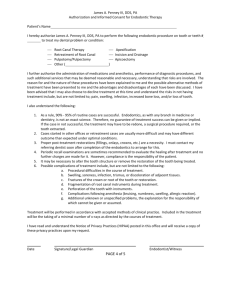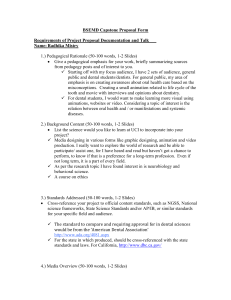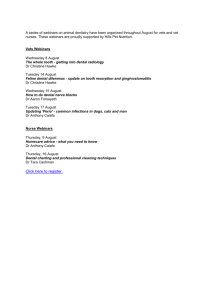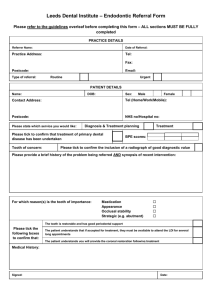Case Report Worksheet - National Health Care for the Homeless
advertisement
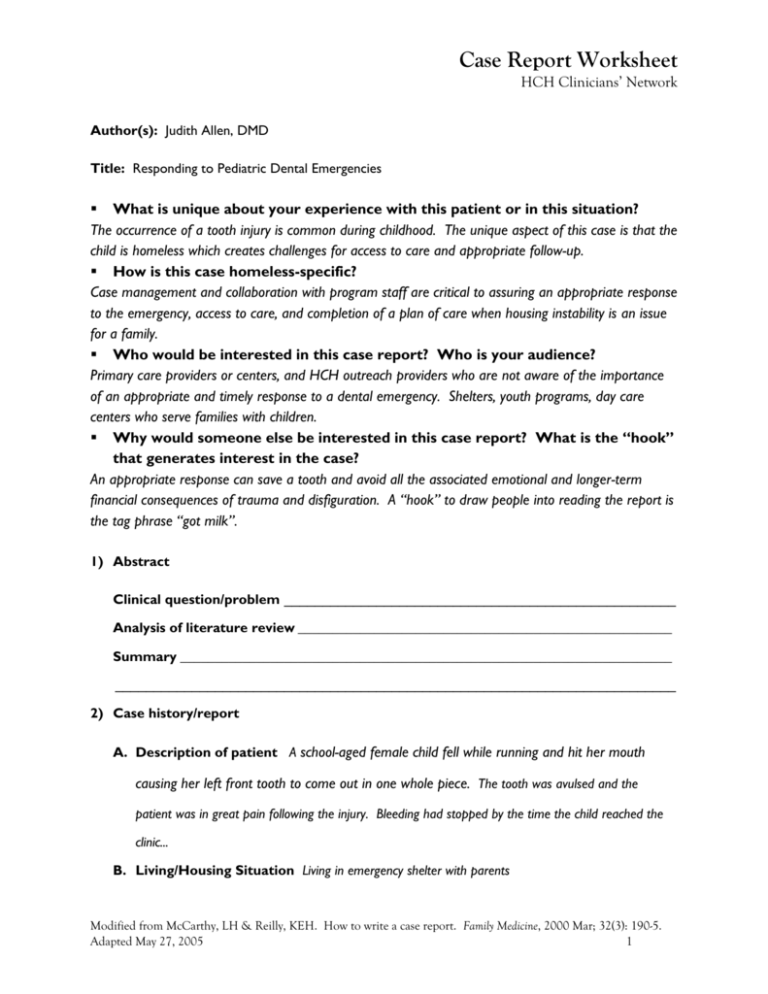
Case Report Worksheet HCH Clinicians’ Network Author(s): Judith Allen, DMD Title: Responding to Pediatric Dental Emergencies What is unique about your experience with this patient or in this situation? The occurrence of a tooth injury is common during childhood. The unique aspect of this case is that the child is homeless which creates challenges for access to care and appropriate follow-up. How is this case homeless-specific? Case management and collaboration with program staff are critical to assuring an appropriate response to the emergency, access to care, and completion of a plan of care when housing instability is an issue for a family. Who would be interested in this case report? Who is your audience? Primary care providers or centers, and HCH outreach providers who are not aware of the importance of an appropriate and timely response to a dental emergency. Shelters, youth programs, day care centers who serve families with children. Why would someone else be interested in this case report? What is the “hook” that generates interest in the case? An appropriate response can save a tooth and avoid all the associated emotional and longer-term financial consequences of trauma and disfiguration. A “hook” to draw people into reading the report is the tag phrase “got milk”. 1) Abstract Clinical question/problem ___________________________________________________ Analysis of literature review ______________________________________________________ Summary _______________________________________________________________________ _________________________________________________________________________ 2) Case history/report A. Description of patient A school-aged female child fell while running and hit her mouth causing her left front tooth to come out in one whole piece. The tooth was avulsed and the patient was in great pain following the injury. Bleeding had stopped by the time the child reached the clinic... B. Living/Housing Situation Living in emergency shelter with parents Modified from McCarthy, LH & Reilly, KEH. How to write a case report. Family Medicine, 2000 Mar; 32(3): 190-5. Adapted May 27, 2005 1 Case Report Worksheet HCH Clinicians’ Network C. History of presenting condition i. Physical Otherwise healthy child, no significant dental or health history ii. Psychosocial The child was participating in a youth program for homeless children at the time of the injury. The staff called the dental clinic seeking advice how to deal with the injury. The dentist advised the staff to place the tooth in milk by only touching the crown of the tooth and immediately transport the tooth in milk, the child with parent to the clinic for emergency dental treatment. The child and tooth were under the dentist’s care within 75 minutes from the injury. iii. Psychiatric Not contributory iv. Substance Use/Abuse Not contributory D. Physical Exam Initial assessment revealed that the tooth was avulsed in whole. No facial or boney fracture. Neurologically intact. Tissue was such that the tooth could easily be reimplanted and splinted for healing. E. Assessment tools applied none F. Relevant lab/x-ray/other tests x-ray of maxilla at left central incisor revealing no fracture G. Relevant social issues The history of the injury, the circumstances, pattern of trauma, and behavior of the child and parent were consistent with a non-abusive incident. The family has limited time remaining at the shelter before needing to leave. H. Initial diagnosis and treatment/intervention Left central incisor avulsion. Using Save-A- Tooth® Emergency Tooth Preserving System (Hank’s Balanced Salt Solution), the tooth was reconstituted for 15 minutes before attempting reimplantation. Following standard dental procedures, the tooth was reimplanted and stabilized with a splint. The child returned to the shelter with antibiotic treatment of Amoxicillin 500 mg TID for seven days and analgesia of Ibuprophen 400 mg every four to six hours as needed. The child was referred to a medical facility for evaluation of tetanus immunization status. The child was to return to the clinic in four weeks for removal of the splint and further assessment. The parent signed a release of information to permit the dentist to communicate with shelter program staff to advocate for a continued shelter stay until completion of treatment and to assist in case management. Modified from McCarthy, LH & Reilly, KEH. How to write a case report. Family Medicine, 2000 Mar; 32(3): 190-5. Adapted May 27, 2005 2 Case Report Worksheet HCH Clinicians’ Network At four weeks, the child returned for removal of the splint. The child reported no pain, no swelling or other post-operative problems. The periodontal ligament of the tooth appeared healed. Examination revealed no mobility of the tooth suggesting reintegration. The patient was scheduled for endodontic treatment two weeks later. The parent agreed to permit the dentist to communicate once again with program staff regarding the need for further care. Two weeks later, the child returned for treatment as recommended. During the endodontic procedure, the tooth was found to be vital, which meant that a live pulp was present. The tooth was completely healed and had not necrotized due to the trauma. Standard endodontic treatment was performed and the child was scheduled for evaluation and assessment in six months. The parent was counseled about the need for continued follow-up every six months and how to access care regardless of location. I. Expected Outcome i. Medical Reimplantation of an avulsed tooth is successful __% of the time. Endodontic treatment is standard treatment following avulsion. ii. Social The child is at great risk for not returning for follow-up care due to the likelihood the family would need to depart their current housing.. Additionally, the competing demands that a homeless family faces may interfere with follow-up care. However, with advocacy and collaboration with the program staff, the likelihood of housing stability would increase and thus, follow-up care would be more likely. The youth program staff knowing who to consult about the dental emergency and subsequent dental guidance they followed saved the tooth for the child. Access to such skilled care for emergencies is not always available due to varied reasons. J. Actual outcome i. Medical The tooth was reimplanted successful with necessary follow-up care completed. ii. Social Housing instability and competing priorities did not interfere with the child receiving appropriate dental treatment. 3) Literature Search Modified from McCarthy, LH & Reilly, KEH. How to write a case report. Family Medicine, 2000 Mar; 32(3): 190-5. Adapted May 27, 2005 3 Case Report Worksheet HCH Clinicians’ Network A. MEDLINE/other database Pubmed, Google B. Search terms see attached page C. Results of search (# relevant, citations, what you learned) see attached 3) Discussion (significance, why you're writing this) A. Relevant literature Substantial literature regarding the epidemiology and the treatment of tooth injuries exists. Accepted standards of care are established as evidenced with 5sets clinical guidelines on the treatment of tooth injuries by professional organizations. First aid for dental emergencies is readily available on the web and in literature. Literature exists demonstrating that those involved with children, even parents, are often uninformed about first aid for tooth injuries. Only one study evaluated the knowledge of emergency room physicians regarding the treatment of a tooth injury that demonstrated only 4% would have provided appropriate care. No literature regarding homeless children and the consequences of tooth injuries exists. . B. Hypothesis If the general knowledge regarding first aid and treatment for tooth injuries is lacking among parents, health care providers, and others caring for children and the risk is at least the same for homeless children as for housed children, appropriate steps should be undertaken to increase the likelihood of a positive outcome when a tooth injury occurs for a child while homeless. In addition to the issues faced by the general population with respect to tooth injuries, a homeless child encounters additional barriers to successful outcomes which include limited access to care, transportation, medical coverage, and the competing priorities associated with homelessness. C. Diagnostic process/course of illness i. Table of diagnostic process N/A ii. Figure, photographs, imaging attached D. Outcomes N/A i. Drug-drug interactions ____________________________________________________ ii. Drug-condition interactions ________________________________________________ iii. Other conflicting outcomes/observations ___________________________________ 5) Conclusions/Recommendations (lesson learned) Modified from McCarthy, LH & Reilly, KEH. How to write a case report. Family Medicine, 2000 Mar; 32(3): 190-5. Adapted May 27, 2005 4 Case Report Worksheet HCH Clinicians’ Network A. General Preparation for responding to a pediatric dental emergency can save a child’s tooth, promote dental health, smile and self-esteem. . B. Clinical Collaborate with shelters or housing agencies to assure that initial care can be completed before the family must move from their current housing. Educate parents regarding the importance of continued monitoring of teeth following a trauma. Assist parents anticipate potential barriers to care and identify solutions to overcome them to assure the child receives care. C. Administrative Assure all staff especially, telephone receptionists and front desk staff are educated to recognize dental emergencies and how to respond. Obtain a Save-A-Tooth® Emergency Tooth Preserving System or equivalent; assure staff know where it is and how to use it Develop a transportation plan for patients experiencing dental emergencies. Establish a referral network and process for the treatment of dental emergencies—whether dental services are available at your health center or available within the community. D. Community Partnerships Educate shelter, childcare, day center or any staff who may be providing services to children to recognize dental emergencies and how to provide first aid. Assist agencies such as shelters, childcare centers or day centers acquire first aid supplies for dental emergencies. Develop an action plan in collaboration with other community agencies that assures a quick response and transportation. Inform shelter, childcare, daycare center or any clinical staff and emergency departments that would treat dental emergencies about the proper handling of avulsed teeth and related dental trauma procedures, including the Save-A-Tooth system. E. Policy N/A 6) References N/A Modified from McCarthy, LH & Reilly, KEH. How to write a case report. Family Medicine, 2000 Mar; 32(3): 190-5. Adapted May 27, 2005 5



